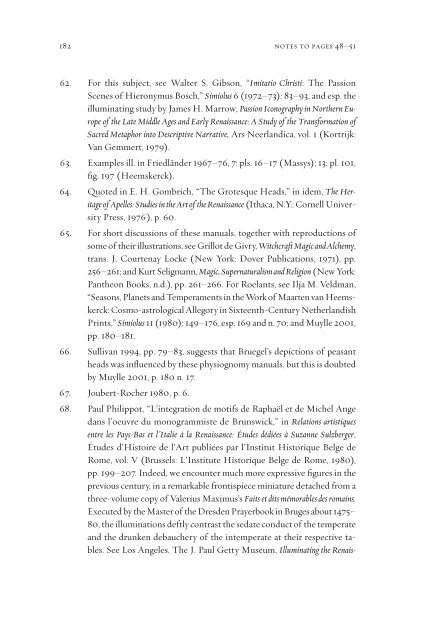Pieter Bruegel and the Art of Laughter - AAAARG.ORG
Pieter Bruegel and the Art of Laughter - AAAARG.ORG
Pieter Bruegel and the Art of Laughter - AAAARG.ORG
Create successful ePaper yourself
Turn your PDF publications into a flip-book with our unique Google optimized e-Paper software.
182 notes to pages 48–51<br />
62. For this subject, see Walter S. Gibson, “Imitatio Christi: The Passion<br />
Scenes <strong>of</strong> Hieronymus Bosch,” Simiolus 6 (1972–73): 83–93, <strong>and</strong> esp. <strong>the</strong><br />
illuminating study by James H. Marrow, Passion Iconography in Nor<strong>the</strong>rn Europe<br />
<strong>of</strong> <strong>the</strong> Late Middle Ages <strong>and</strong> Early Renaissance: A Study <strong>of</strong> <strong>the</strong> Transformation <strong>of</strong><br />
Sacred Metaphor into Descriptive Narrative, Ars Neerl<strong>and</strong>ica, vol. 1 (Kortrijk:<br />
Van Gemmert, 1979).<br />
63. Examples ill. in Friedländer 1967–76, 7: pls. 16–17 (Massys); 13: pl. 101,<br />
fig. 197 (Heemskerck).<br />
64. Quoted in E. H. Gombrich, “The Grotesque Heads,” in idem, The Heritage<br />
<strong>of</strong> Apelles: Studies in <strong>the</strong> <strong>Art</strong> <strong>of</strong> <strong>the</strong> Renaissance (Ithaca, N.Y.: Cornell University<br />
Press, 1976 ), p. 60.<br />
65. For short discussions <strong>of</strong> <strong>the</strong>se manuals, toge<strong>the</strong>r with reproductions <strong>of</strong><br />
some <strong>of</strong> <strong>the</strong>ir illustrations, see Grillot de Givry, Witchcraft Magic <strong>and</strong> Alchemy,<br />
trans. J. Courtenay Locke (New York: Dover Publications, 1971), pp.<br />
256–261; <strong>and</strong> Kurt Seligmann, Magic, Supernaturalism <strong>and</strong> Religion (New York:<br />
Pan<strong>the</strong>on Books, n.d.), pp. 261–266. For Roelants, see Ilja M. Veldman,<br />
“Seasons, Planets <strong>and</strong> Temperaments in <strong>the</strong> Work <strong>of</strong> Maarten van Heemskerck:<br />
Cosmo-astrological Allegory in Sixteenth-Century Ne<strong>the</strong>rl<strong>and</strong>ish<br />
Prints,” Simiolus 11 (1980): 149–176, esp. 169 <strong>and</strong> n. 70; <strong>and</strong> Muylle 2001,<br />
pp. 180–181.<br />
66. Sullivan 1994, pp. 79–83, suggests that <strong>Bruegel</strong>’s depictions <strong>of</strong> peasant<br />
heads was influenced by <strong>the</strong>se physiognomy manuals, but this is doubted<br />
by Muylle 2001, p. 180 n. 17.<br />
67. Joubert-Rocher 1980, p. 6.<br />
68. Paul Philippot, “L’integration de motifs de Raphaël et de Michel Ange<br />
dans l’oeuvre du monogrammiste de Brunswick,” in Relations artistiques<br />
entre les Pays-Bas et l’Italie à la Renaissance: Études dédiées à Suzanne Sulzberger,<br />
Études d’Histoire de l’<strong>Art</strong> publiées par l’Institut Historique Belge de<br />
Rome, vol. V (Brussels: L’Institute Historique Belge de Rome, 1980),<br />
pp. 199–207. Indeed, we encounter much more expressive figures in <strong>the</strong><br />
previous century, in a remarkable frontispiece miniature detached from a<br />
three-volume copy <strong>of</strong> Valerius Maximus’s Faits et dits mémorables des romains.<br />
Executed by <strong>the</strong> Master <strong>of</strong> <strong>the</strong> Dresden Prayerbook in Bruges about 1475–<br />
80, <strong>the</strong> illuminations deftly contrast <strong>the</strong> sedate conduct <strong>of</strong> <strong>the</strong> temperate<br />
<strong>and</strong> <strong>the</strong> drunken debauchery <strong>of</strong> <strong>the</strong> intemperate at <strong>the</strong>ir respective tables.<br />
See Los Angeles, The J. Paul Getty Museum, Illuminating <strong>the</strong> Renais-












